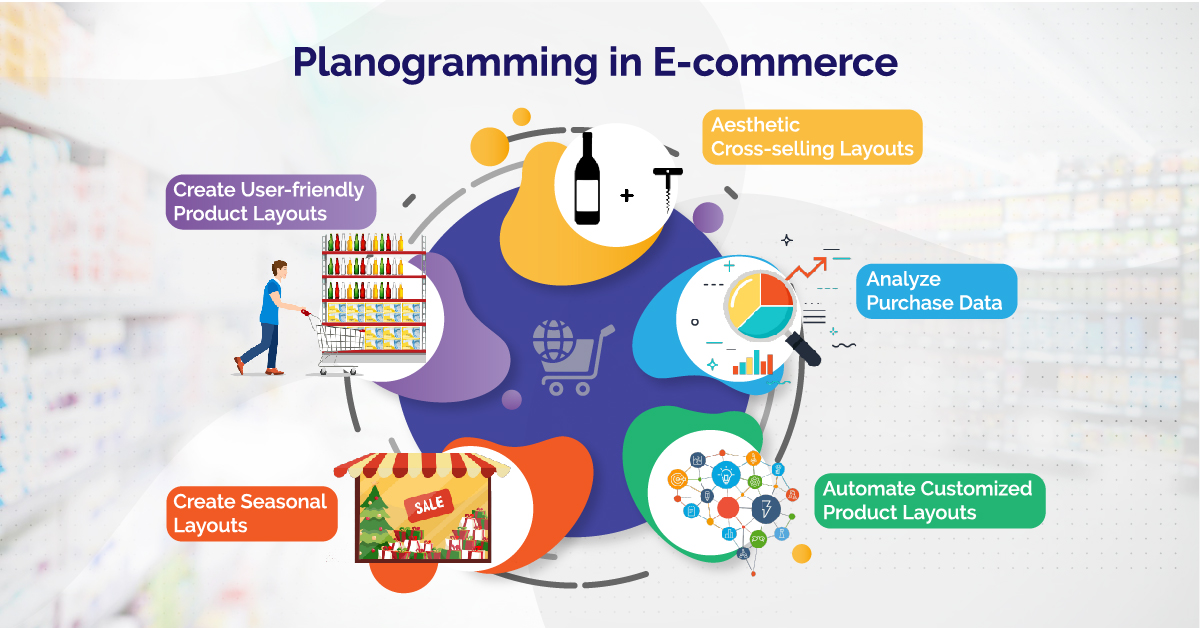Ever since its humble beginnings in the early 1990s, e-commerce sector has experienced rapid growth with a projected sales growth of 599.2 billion USD by 2024. Accessibility and convenience, lower prices combined with wider choices have made online shopping a preferred alternative among today’s busy shoppers.
Now that more and more retailers are embracing digital platforms to sell their products, visual merchandising has become an important tool to maximize sales regardless of the channel. Planogram is one such tool that aids in this direction. Planograms are visual representation software often used to get a detailed drawing of a store layout – including product, shelf and aisle. Planograms play a vital role in optimizing the available space by ensuring availability of the right product at the right time and place. Recent studies have suggested that more than 60% of purchase decisions are a result of impulse buying. Therefore, a well-designed planogram can be vital in motivating customers to buy products other than the ones they are specifically seeking.
With an increasing trend favoring online sales compared to brick-and-mortar, marketing tactics have also changed vastly. However, planogram remains an ideal choice for both- a physical store or an online website.
Planogram for an online store should not be just about page layout or placement of pictures on the website. Simply showing “You may also like” may work only in a short run because customer’s shopping habits are varied. The ultimate goal should be to create personalized shopping experiences for customers with product suggestion to go along with every product. Sometimes placing the right accessory that compliments the product may be the deciding factor for whether the item is purchased nor not.

Tips to ensure efficiency of E-commerce planogram
- Analyze previous purchase data: If a planogram is being implemented in an existing online store, analyzing previous purchase data will be informative in designing a better layout. For example, if you sell mobile phones and people often buy power bank with them, consider placing the power bank next to mobile phones in your planogram.
- Curate, Curate, Curate: In situations where past purchase data is not available, online stores can create pages as collections and lay them out using a planogram. For example, if your store sells clothing and accessories, create outfits that complement well. Planograms can be used to lay pieces of outfits near each other – thus enabling customers to envision how the complete outfit would look like. This technique can be done with a wide range of products including food items that blend well, electronics and accessories that improve their usage and much more.
- Think Seasonally: Alter your planograms according to the upcoming season, festival or holiday. For example, during winter season demand for jackets, blankets and sweaters tend to increase. Similarly, if a festival is coming up feature products that fit with the occasion. By changing planogram layout at appropriate intervals, you can ensure that customers are seeing what they are likely to buy more.
- For Ecommerce Planogram Success, Test: Designing and implementing an e-commerce planogram alone does not guarantee success. Testing planograms at regular intervals are essential to ensure efficiency and success rate of planograms. For example, changing planograms layout at regular intervals and analysing variation in sales after each layout enables e-commerce stores to identify what works best.
E-commerce planogramming using Nexgen POG
Nexgen POG is a powerful cloud based visual merchandising tool designed for quick and easy planogramming. Planograms can be designed by easily dragging and dropping the products. It is also equipped with vast array of features including customizable templates, multi device compatibility, easy compliance, manual and automated modes among many others-thus making Nexgen POG a preferred choice among brands worldwide. To understand Nexgen POG’s e-commerce applicability better, let’s consider the following example:
Company profile: In this example we will be discussing about a leading video on demand service platform that has an OTT application for movies.
Business Challenge: The main challenge was to have a customer friendly homepage for their website. The website has a moving banner showing recent movie posters that change at certain intervals. However, this was being done manually rather than using Artificial Intelligence. Their main requirement was a system where movie banners would automatically change according to set criteria; for example, movies that are high on demand or movie that got maximum clicks.
Solution through Nexgen partnership: Here Nexgen POG would use Artificial intelligence to analyse click data and create appropriate planograms to be transferred into company’s system- thereby ensuring better customer experiences to viewers.
Get your free trial now. Try Nexgen POG for free